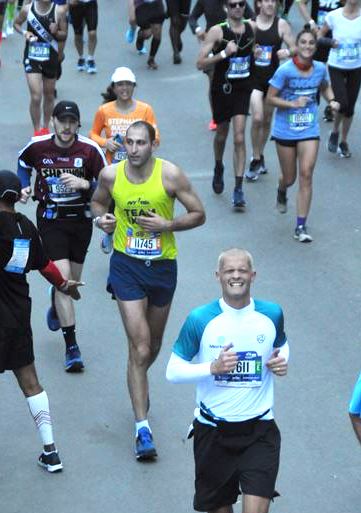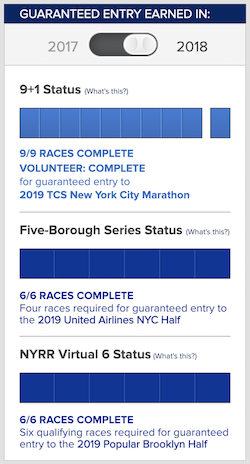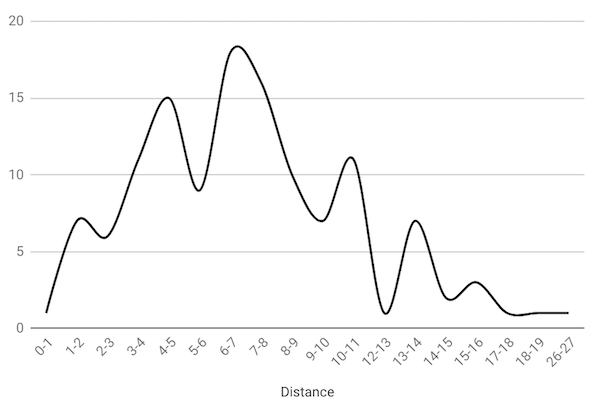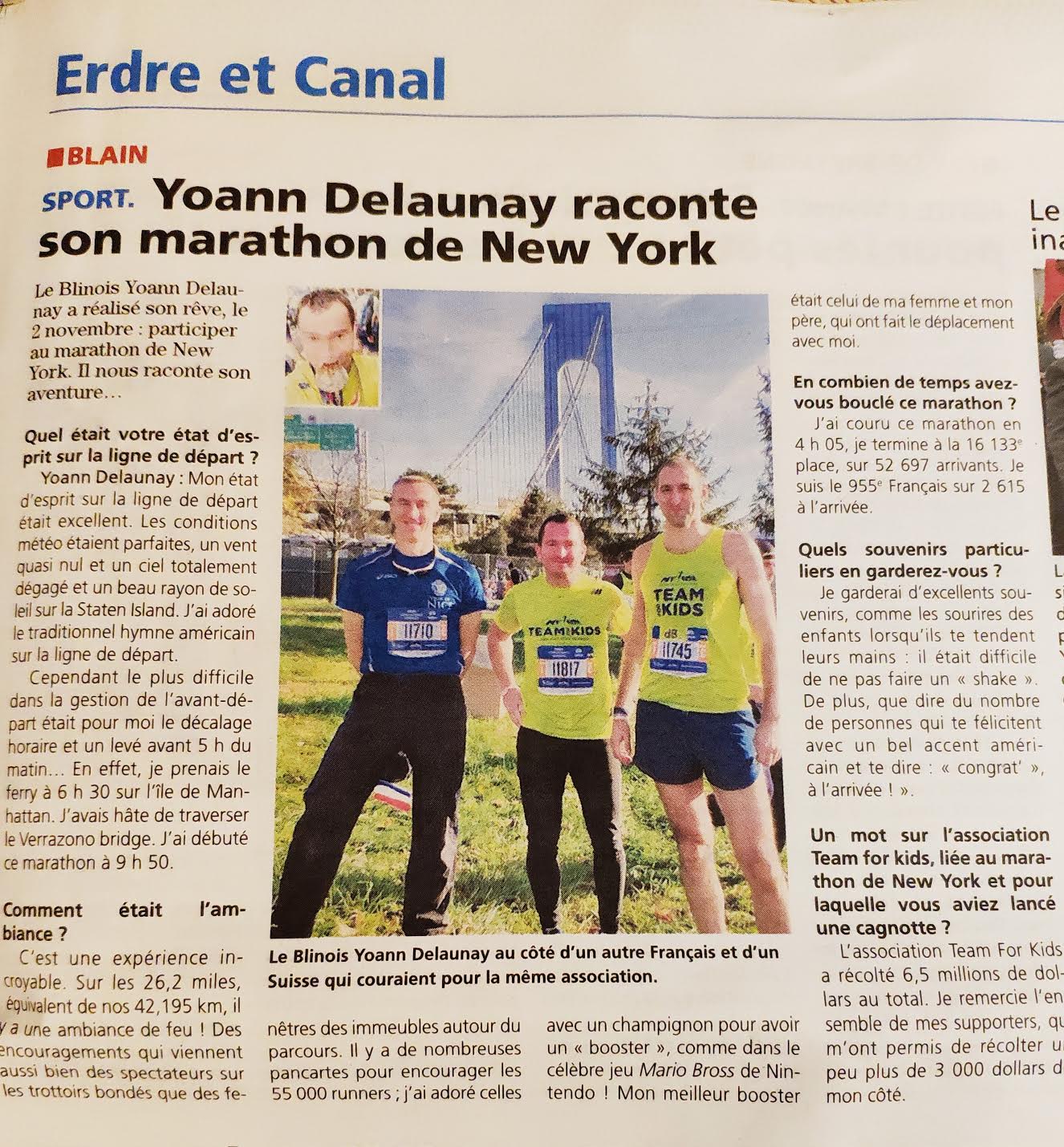Yesterday I ran my first ever marathon, the TCS NYC Marathon 2018.
If a 42 year me (who always felt that running was a punishment) can do it, you can, too!

… looking misleadingly fresh compared to the guy in front of me
I’ve watched many New York City marathons with a beer at hand, and it has always inspired me. But how did 50,000 runners get into it? Where did they come from? The whole New York running business was new to me just a year ago, and I had to piece together the necessary information about registering and running for my first race, then eventually figured out how to run this marathon. This post will demystify a path to the New York City marathon, the greatest marathon on earth. I won’t talk about the run itself.
Getting into a Race
The process of getting into the marathon may be slightly different each year. In general, you can enter the NYC marathon in the following ways: charity, lottery, via an international tour operator, a qualifying program or a qualifying time. Next year’s information, and a link to enter the lottery, can be found at www.tcsnycmarathon.org/plan-your-race.
Whichever way you get into the marathon, head to www.nyrr.org and create an account. Get the NYRR app, too. You will receive a code via NYRR or from your charity, or will be able to sign up for the marathon lottery via that website or the app.
Running for Charity
Assuming you’re not a superhuman runner with a marathon qualifying time, the easiest way to get in is to run with a charity, which is what I did in 2018. It’s the most recommended expedient way for both New Yorkers and those traveling in, because you are giving your money to a good cause and not a tour operator.
The default New York Road Runners charity is Team for Kids (TFK). I have signed up on their website, made a donations page and spent the year throwing parties, giving away my drawings, and asking my friends for a bit of cash to reach the goal of $2,600. If you can’t raise the entire amount, you just pay the difference. I felt great about every cent raised, because, unfortunately, the kids from poor communities in New York really needed this money to get access to basic physical education programs. Note that I still had to pay the race entry fees, which was couple hundred dollars, on top of the money raised for the charity.
Additionally, running with TFK was the best possible experience money could buy, before, during and after the race!
During the year leading to the marathon volunteer trainers took us running almost every week, and paced us through long training runs. These were some incredibly nice and amazingly qualified people that you otherwise couldn’t get access to, including the omnipresent marathoner and ironman Michael Rogers. Then, the last training run of 2018 was led by Boston and NYC marathon champion, Olympic silver medalist Meb Keflezighi. Humbling and inspiring.
TFK organized talks about mental prep for the marathon. Volunteers were incredibly responsive to e-mails.
TFK got me into the 12, 15 and 18-mile training runs in summer and fall of the year, for free, saving me about $100. They charted multiple ferries from 34th street landing to Staten Island the day of the race and set up a warm tent used while waiting for the corrals to open. They brought baggage to another warm tent reserved for TFK runners at the finish line. A TFK volunteer handheld me to it, and another volunteer served me coffee and sugar while being extremely patient with me being completely happy, yet delirious.
Running via the 9+1 Program
If you are lucky to live in New York and are fine waiting for another year before running the marathon, commit to the NYRR 9+1 program. This involves running at least 9 qualifying races during the year and volunteering for 1 (or giving $1K to charity) to receive guaranteed marathon entry the year after. You can read my post on how to run a race in NYC for details.
I earned my guaranteed spot for next year’s 2019 marathon (and a few other races) through this program.

… guaranteed entry into 2019 Marathon, United Airlines and Popular Brooklyn Halfs
Training
Running a marathon seemed easy while holding my beer and cheering from the sidelines. Once I ran 2-3 miles uninterrupted, I didn’t feel that way, at all. A marathon is a daunting 26.2!
Putting in Time
I’ve never run longer than a couple of miles until a year ago when I started running regularly, 2-3 times a week. A year later I have logged 122 total runs in Strava, mostly in the 6-8 miles range. I also ran a mile or two on the treadmill every time I worked out at the gym, 2-3 times a week (not pictured below).

… number of runs vs. distance, minus treadmill runs
I spent a year running and felt that I could use another month or two before the marathon. That said, I would have felt major FOMO watching the 2018 marathon.
Long Runs
I did a bunch of half marathons and completed a 15 mile run in August, which felt a lot harder than 13, probably because I was trying to go slower. My longest training run was 18 miles around Central Park in September and it did not go well at all. I paced well in the beginning, but then started feeling very dizzy half way through. Tried to walk it off, but just got worse. Head spinning, smelling like death. Mile 9 to 18 were mostly walking and crawling. A few weeks later I was able to run 17 without feeling like I was failing. I basically had one good very long run before the marathon and never hit the recommended 20 miles, I just ran out of time.
Eating and Drinking
I learned to carb load on pasta and chicken and drink more water days ahead of each race. Following some advice from ultra-marathoners I started eating a gel 15 minutes before a race, then eating a gel every 40 minutes while running, plus water every 2-3 miles, especially during long distances. It took a while for my body not to react negatively to this, and contributed significantly to not dying from lack of energy during the marathon.
Cross-Training
My favorite training days included running 4 miles and working out at the gym, mostly a combination of upper body and legs. I think that helped a lot.
Before the Race
Transportation and Baggage Options
I made my transportation and baggage choices as soon as I got a notification about it. I had to choose between getting a post-race poncho or checking in a bag. Running with TFK allowed me to select a comfortable 6:30 AM ferry time from 34th street landing on the East Side of Manhattan, but most people took the Staten Island ferry from downtown or a bus from midtown. With 50,000 runners lines got long, and it took at the very least an hour to get to the race village.
People loved the poncho for some reason, so I picked that the first time. It’s warm and thick, but I think next year I’ll want to put on pants after the race and not look like I was part of some blue cult.
Picking up a Bib
I had to pickup the marathon bib at the TCS Marathon pavilion at the Javits center a few days before the race. This was on 34th street, all the way west in Manhattan. It was quite a venue with a lot of running merch vendors and tons of free samples.
I got some safety pins to pin the bib, a clear bag and a post-race poncho bracelet, a T-Shirt, a magazine, etc.
Because 50,000 people ran, the marathon had a staggered start. The bib identified my wave (a number, eg. wave 1) and corral (a color and a letter, eg. orange C). This told me when I had to be inside the corral and when I was going to start running.
Picking a Target Pace
My fastest half marathon was 1h35m at 7:18/mile pace. While I felt increasingly better about my longer runs with time, the pattern of running slower and failing towards the second half of the race was really worrying me. Everyone would tell you that you can’t just multiply your half marathon time by 2 to complete a full marathon, you must run slower. The goal of my slower training runs was to answer “How much slower?” and none of the runs were successful enough to do that.
Two days before the marathon I got to run with Meb Keflezighi and asked him what my target pace should have been. He said to add 40 seconds to my 7:20. I decided to follow his professional advice, but got too excited and went out around 7:30, had some 7:59s uphill, and was able to keep that pace roughly through mile 21. Had I done 8:00, I think I could have kept that all the way.
Shake Out Run
I highly recommend running a couple of slow miles in Central Park a day or two before the race. The park was packed with visting runners, the marathon finishing line was being prepared and I got super pumped being there. Central park is also incredibly beautiful this time of year.
I did two short 2-3 mile runs, one with TFK two days before the race, and another with my neighbor, a casual and extra slow runner, the day before. I should have signed up for the Abbott Dash to the Finish Line 5K, a regular NYRR race the day before the marathon.
The Race
Getting to Staten Island
I didn’t take any money or ID with me, just my running watch, and ordered an Uber to the ferry. A bus took us to the marathon village. Because I ran for charity we had a heated tent with bagels, bananas, power bars, coffee, trainers and helpful volunteers guiding us around. The ferry left at 6:30AM and I was ready to run at 8:00AM. Corrals opened shortly before 9 and the actual race start was set at 9:50AM. The makeshift marathon village was quite vast, so I had to make sure to take my time to find the corral by following the signs.
Despite a perfectly sunny November day, the corrals were mostly entirely in the shade, so everyone got very cold. I made a mistake to toss a pair of pants into a donation bin when leaving the sunny tent area, so I highly recommend keeping your throwaway clothes on until you are either walking or are on the Verrazano bridge, seconds before the start.
The Start
I heard multiple cannons announcing the start of the professional wheelchair division, the Achilles handcycle category and select athletes with disabilities while packed inside the corrals. Every participant and volunteer helping in these categories should get two medals, IMHO. Professional women started next. There was be a little bit of cheering in the far that you could hear from the village, but nothing major.
I chatted with some French-speaking runners who traveled to New York for the marathon. One of them landed me into a local French newspaper.

I began realizing how massive the marathon was only when I got out to the starting line on that incredible Verrazano bridge. There were people climbing on the divider to take selfies. Police helicopters flew super low above us. The national anthem was performed and I jumped, feeling the cannon bang in my stomach. We started running.
The Run
The Verrazano-Narrows Bridge is among the few major crossings in the metropolitan area without a lane for pedestrians and bicyclists, so this was a unique experience. The city view is breathtaking. If you made it here, you’re running. Your only option now is to cross the finish line! Stay calm, relax, and let the run come out of you.

